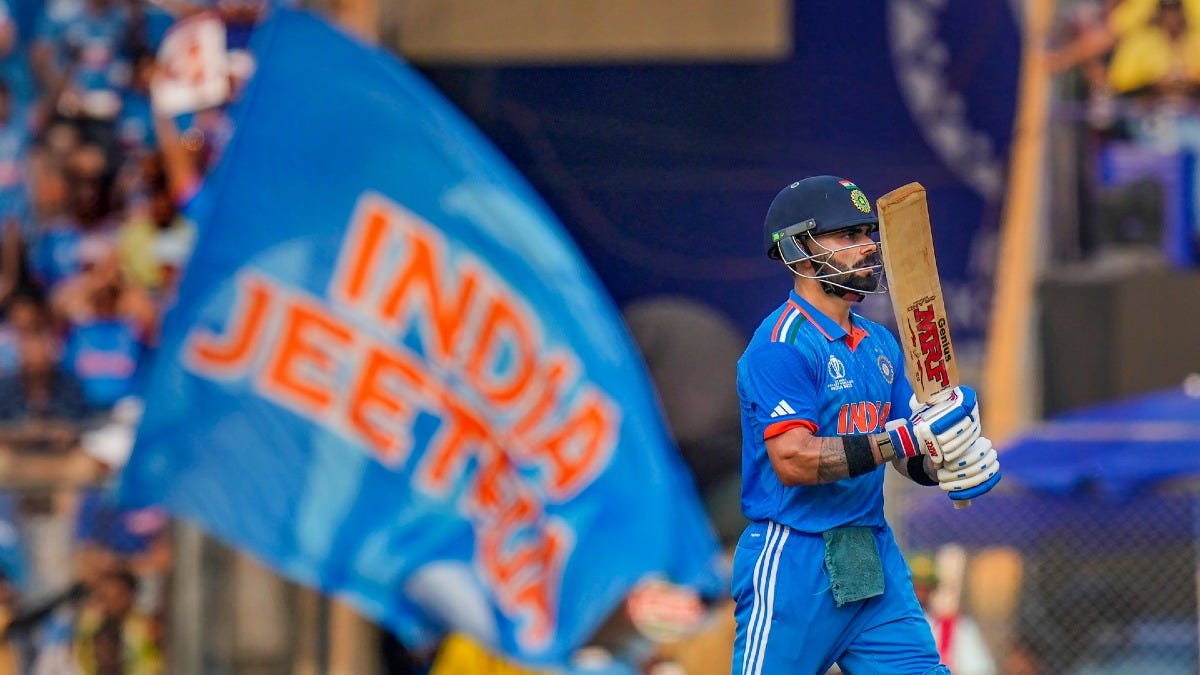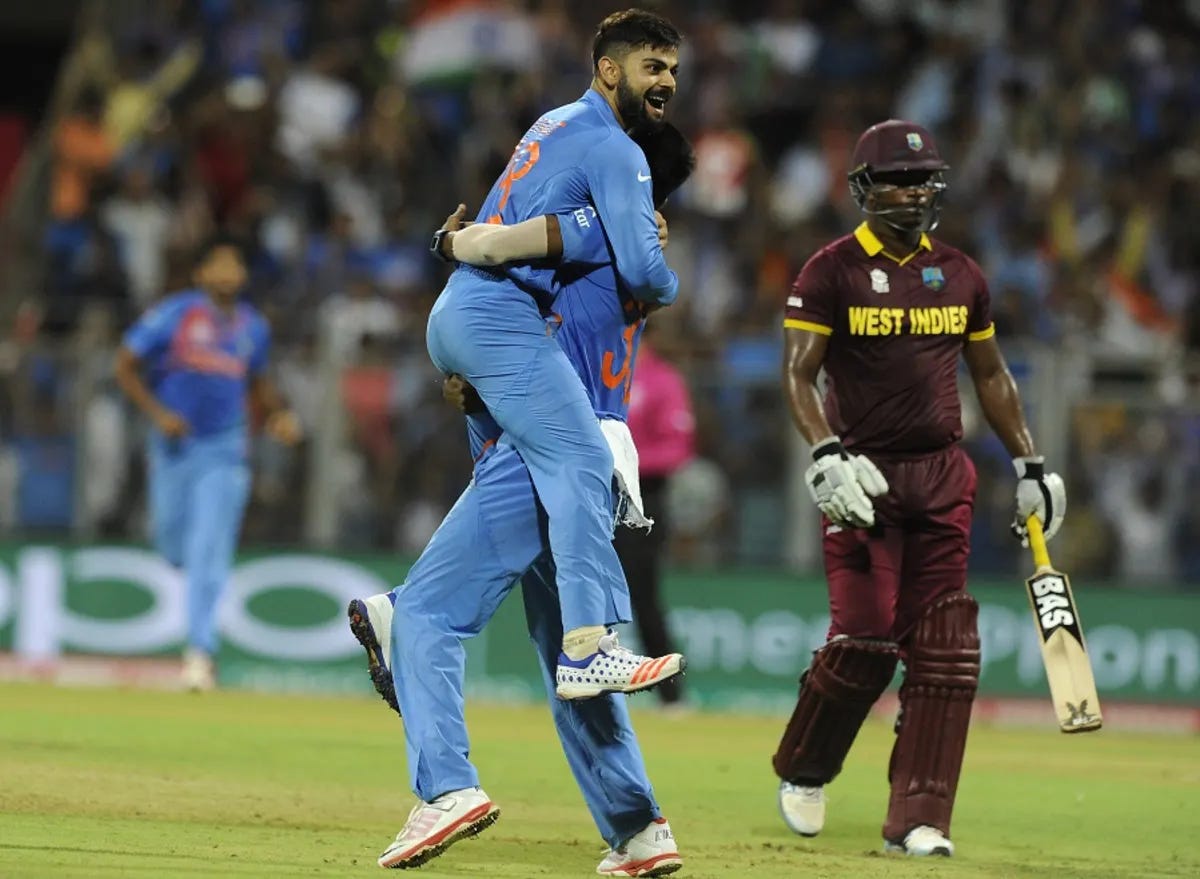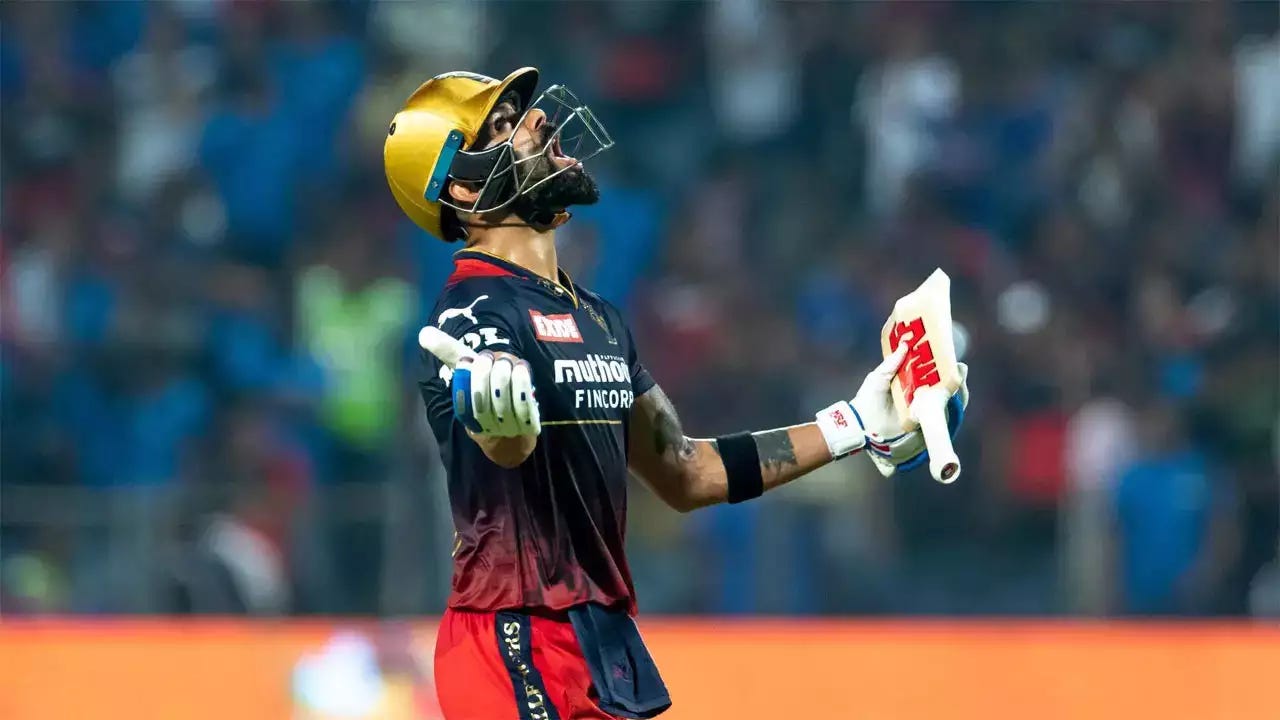📢 On Virat
He entered as a brat, briefly became God and left a man
Virat Kohli had passed fifty on 216 occasions in his career until that moment. But, the reaction the 217th drew on that November afternoon in Ahmedabad seemed to overwhelm him.
Normally, Kohli marks the milestone with a bat raise seeped in defiance and determination. A bat raise that simultaneously acknowledges the crowd and throws down the gauntlet to the opposition. There’s an air of the Kobe Bryant ‘job not finished’ to the act.
But, the one in the World Cup final was different. Those eyes, which normally burn with an arrogance that forms such a key part of his arsenal, softened with humility. The absence of the helmet grill laid bare his vulnerability as he pursed his lips and soaked in the outpouring from the stands.
That a man of his fortitude had his concentration momentarily broken told you all you need to know about the atmosphere in the Modi dome. Kohli Mania™️ had hit its peak in the preceding weeks but this felt different.
One part of it, of course, was the crowd acknowledging a well-made fifty in a key phase of a home World Cup final. But to me, it felt a reaction evoked more by the man than his innings. The overwhelming emotion was gratitude. Here was Virat again, fighting for us on the biggest of stages. Exactly as he’d done for the past decade.
He’s always been capable of sparking unbridled passion among fans but what emanated from the stands that day felt purer. It was marked by a realisation that seemed to hit both parties at the same time. The end was nigh. The R word had been thrown around all through the tournament but in that moment, it never felt nearer.
I felt a lump form in my throat as I watched him nod along in quiet thanks to the thunderous applause. India’s eventual loss in the final rendered this moment a footnote, but it was a defining one in my relationship with Virat Kohli.
Prior to Virat, only two other cricketers had legitimately occupied a spot on my favourites list - Mohammad Kaif and Mark Boucher. The former for his role in the 2002 Natwest final chase and his proclivity for diving around in the field. The latter for his role in South Africa’s 435 chase and his exquisite GM gear.
Virat took on that mantle sometime in 2011, for an equally flimsy reason - the teenage urge to stand out. At a time when everyone around me was a Sachin, Yuvraj or Dhoni fan, professing love for the buccaneering Delhi batter felt like the epitome of cool.
There was anyways something anti-establishment about Virat. The aggression, the cheek and the stubble all stood in stark contrast to the accepted image of an Indian cricketer at the time. The buzzword at the time was temperament and Kohli’s brashness was believed to indicate his lack of it.
I took on the naysayers with a vigour, less out of a conviction in Kohli’s talent and more because of the fact I had planted my flag down too firmly to just uproot it.
But soon enough, I could lay down the propaganda machine. The 133* against Sri Lanka at Hobart in 2012, the hundred in each innings at Adelaide in 2014 and the century against Pakistan in the 2015 World Cup opener already had some consecrating him as Sachin's heir.
My infatuation grew significantly in these years but it reached a crescendo during the 2016 T20 World Cup.
In the pseudo quarter final against Australia, he played what I consider his finest white-ball knock. He was 50 off 40 balls at the end of the 17th over as India went about chasing 160. He finished with 82 off 51. The 4,4,6 off James Faulkner in the 18th over was eternal. The four behind point of an outside-off yorker, exquisite.
In the semifinal, West Indies were making light-work of chasing down India’s 193 when in a moment of desperation, Dhoni threw the ball to Kohli. He hadn’t bowled all tournament but that didn’t stop him from dismissing the set Johnson Charles on his first ball.
The crowd, which was already at fever pitch after Kohli’s scorching 89 in the first innings, went ballistic. I was at the Wankhede that night and I remember turning to my father and saying ‘Is there anything this man can’t do?’. As it turned out, winning the semi final was one such thing.
But, I left the stadium hypnotised. Players had made me feel safe before, but no one until then had made me feel invincible. Anything felt possible with Virat. This emotion would become the foundation of my fandom. His record breaking numbers in the IPL season that followed the World Cup only furthered this feeling.
I’d just about started growing facial hair that summer and I’d go to my local barber with a picture of Kohli from a magazine cover and ask to have my beard styled like his.
Kohli’s legend grew, I grew up and somewhere along the way, I went inwards in my attempts to model him. There’s a line about Kanye, someone from his circle says in his Netflix documentary Jeen-Yuhs - ‘He was so good because he wanted to be’.
The same is applicable to Kohli. Grind to glory stories are always intoxicating and his even more so. The contrast between the near-mechanical manner in which he churned out runs and the inherently-human way in which he harnessed his emotions to maintain that flow made for a devastating concoction.
For someone in their early 20s, he gave meaning to words like willpower. He personified self-improvement. He exemplified discipline. The strut that accompanied the sweat only added to the allure. You watched Kohli and thought this is what an actualised human being looks like.
Indian cricketers have commanded respect in the past, but none stoked fear in the way he did. The chest-thumping made your own burst with pride. If Virat isn’t cowering, why should I?
You felt his fire. You followed it. With the benefit of hindsight, the burnout was inevitable.
The barren stretch between 2020 and 2022 altered my relationship with him. For most of my adolescence and my entire adult life until then, Virat Kohli scoring runs and winning matches for India had been a constant. To suddenly have that taken away felt immensely unsettling.
Was my fandom really just built around something as superficial as centuries?
The longer the drought went on, the more I immersed myself in introspection. It made me question the sustainability of passion - something I had learnt to consider a building block of success. It made me wonder if beyond a point, confidence is but a facade. It made me think whether hard-work can compensate for talent only up to a certain limit.
The core of the issue was that I struggled to accept the mortality of a man I had put on a pedestal for so long. I struggled to let go of what I felt at Wankhede in 2016.
The runs and bat-raises eventually did return but that feeling of invincibility within never quite did. We sports fans can be so fickle.
One of my father’s favourite pieces of cricket writing is a piece Indian journalist Siddhartha Vaidyanathan wrote for ESPNCricinfo titled ‘Growing up with Sachin’, in which he goes into how Sachin made a generation of Indians make sense of life.
It’s an astonishing piece of writing but I never quite resonated with its sentiment. But watching Kohli raise his bat during the World Cup final, I felt Vaidyanathan’s words more keenly than I ever had before. There are a few moments in life when you feel the passage of time. And that was one of them.
I had grown up with Virat. But, it also felt like he’s grown up with me. Sachin entered an angel and left as one too. Virat entered a brat, briefly became God and left a man.
For my generation of Indians, for a brief period, we felt we were Virat.





You write so well Shubi, just brilliant. Keep up the great work